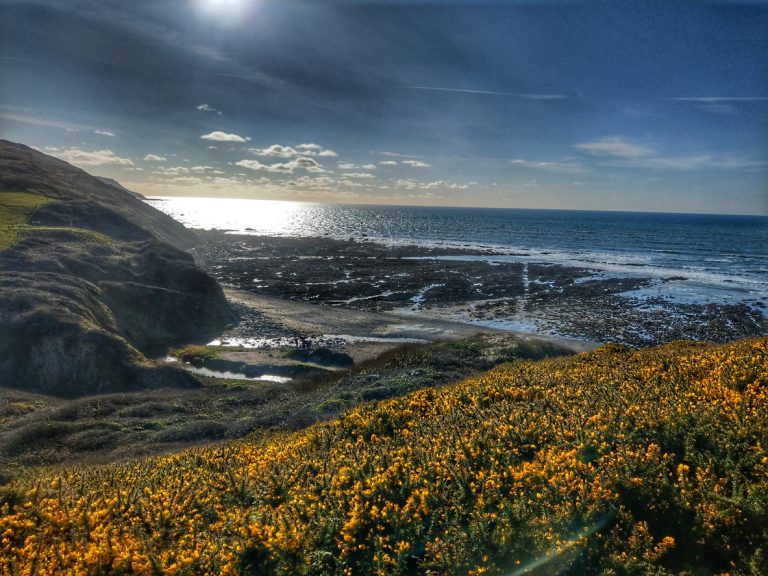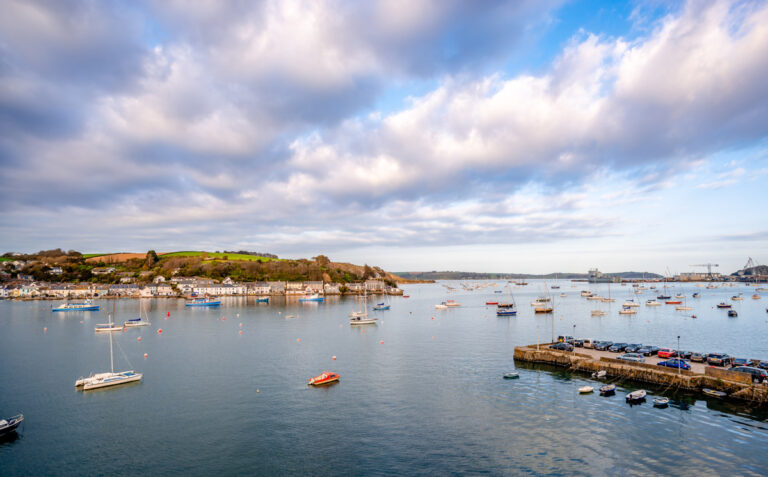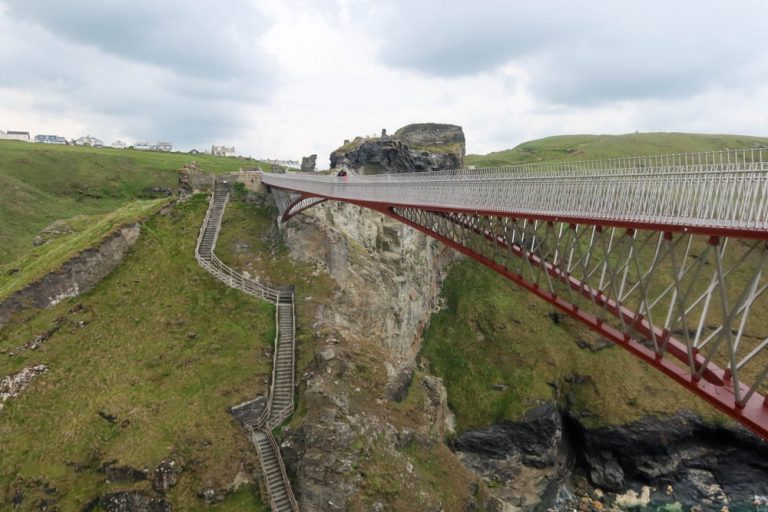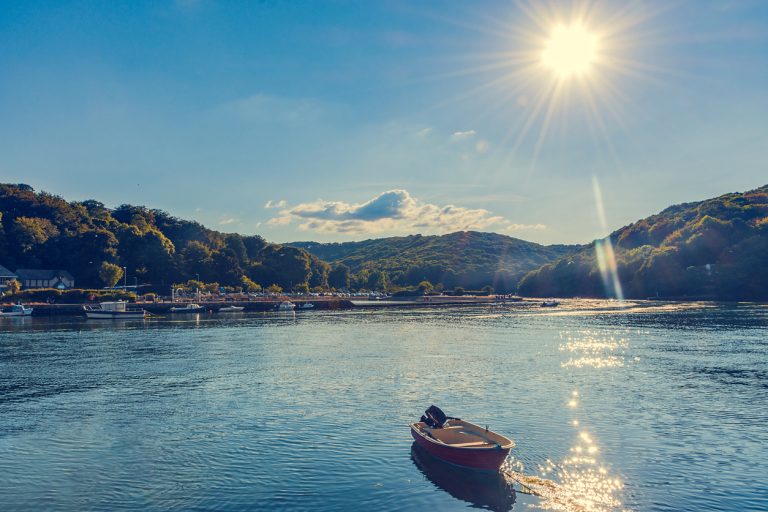Where to see dolphins in Cornwall – lookouts and boat trips
Can you see dolphins in Cornwall? YES, you definitely can! Let’s dig into where and how!
Blink and you could be in the Caribbean… I always find myself thinking when I’m in Cornwall in the summertime.
With bright blue waters and beaches that wouldn’t look out of place in the Med (head to Pedn Vounder to see what I mean!), it should come as no surprise that dolphins are fairly regularly spotted in Cornish waters!
While you’re certainly not guaranteed to see them while you’re here, head to well-known dolphin-spotting locations, be patient, and you might well be lucky…
I’ve seen dolphins all over Cornwall throughout the year – here’s all you need to know about seeing them!
Where to spot dolphins in Cornwall
Here are some of the best places to spot dolphins in Cornwall:
Around Land’s End

Land’s End, Britain’s most southwestern point, offers more than just its famed dramatic granite cliffs and rugged landscapes.
It’s a haven for wildlife enthusiasts, a place where the vast Atlantic stretches out and a canvas for nature’s most enchanting displays.
Here, amidst the dramatic geological features, you can often spot playful dolphins in the water below!
Grey seals often make an appearance too, alongside the occasional basking shark.
You can also see them on the coastline nearby – I spotted them near Nanjizal Beach once.
So, next time you’re in Land’s End, pull yourself away from the attractions and spend a while on the actual southwesternmost point – you’ll be amazed at what you can see!
Lizard Point

Cornwall’s other extremity, Lizard Point is the southernmoust part of England and is also an excellent place to see dolphins.
One of my favourite places in Cornwall (it’s like Land’s End, but without the tourists!), Lizard Point is a fantastic location to watch out for marine mammals.
The National Trust Wildlife Watchpoint is an excellent place to position yourself as you watch out for the playful creatures, or just keep your eyes peeled anywhere on the South West Coast Path as you hike around.
Check out my guide to The Lizard here!
Padstow
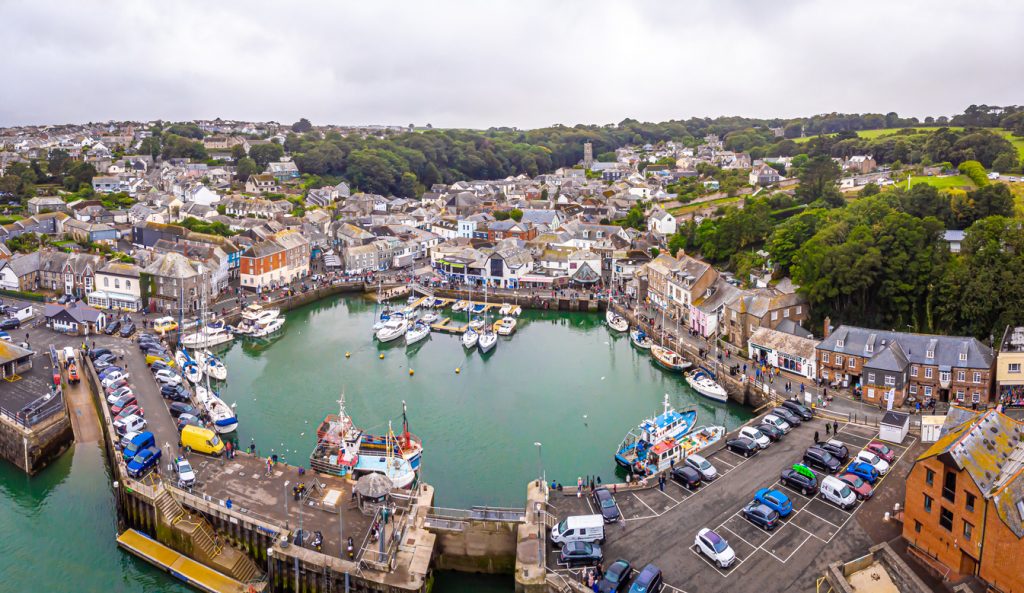
You won’t see many dolphins in the actual harbour town of Padstow, but the North Cornwall waters are brimming with places to spot to creatures!
Access them by taking one of the renowned Padstow Sealife Safaris.
These safaris are an unparalleled opportunity to explore the rich marine life that flourishes in the waters around Padstow. Expect to see playful seals, diverse seabirds, and, most notably, dolphins!
Padstow Sealife Safaris are known for their commitment to both entertainment and education, so not only may you very likely see dolphins, but you’ll also learn lots of fun facts about them!
Newquay
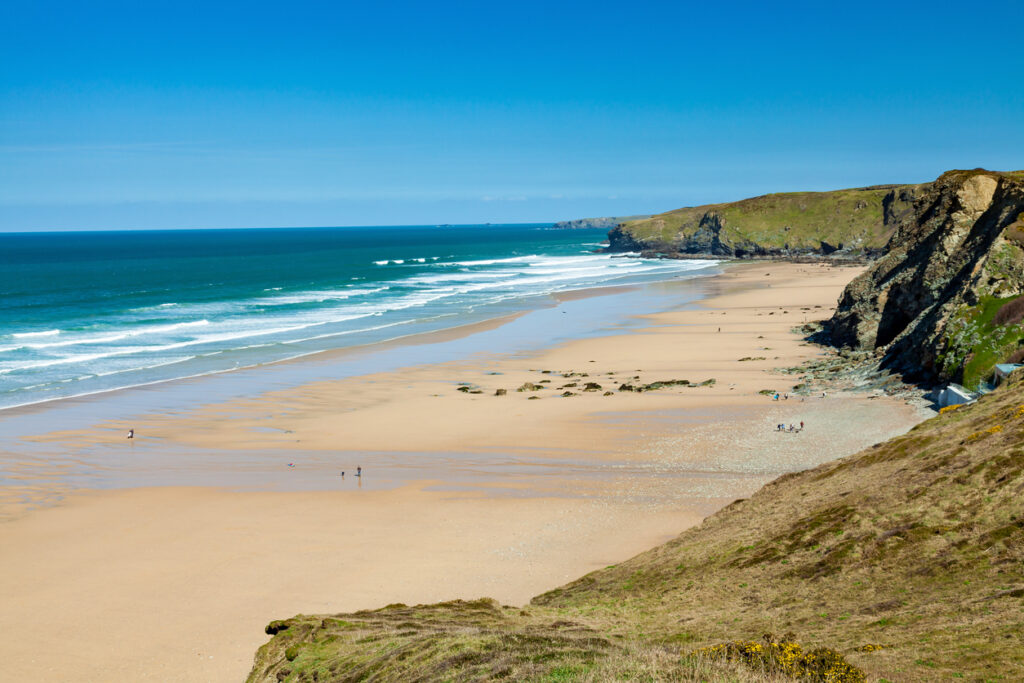
Newquay, North Cornwall’s busiest coastal town, is renowned for its vibrant surf culture and stunning beaches, particularly the world-famous Fistral Beach.
With so many epic beaches just a stone’s throw from the town, it’s unsurprising that plenty of dolphin species live in the waters here!
I’d recommend heading out with Newquay Sea Safaris to see what you can see.
This two-hour sea safari, departing from the old historical Newquay harbour, is ideal for seeing wildlife including the famous Newquay Grey Seals.
The highlight of the trip is Seal Cove, where you can see the seals in their natural environment – and then you’ll speed into deeper waters where you might see dolphins, Basking sharks, Sunfish, Harbour Porpoises and a diverse array of seabirds.
The safari also offers a glimpse into the local fishing practices, as you may see the skipper hauling in lobster pots!
It’s also possible to see dolphins at some of the high cliffs around Newquay, such as by Bedruthan Steps.
Mount’s Bay

Mount’s Bay, sitting on the southern coast of Cornwall, stretches from Land’s End to Lizard Point.
It’s a prime location for seeing dolphins in West Cornwall!
Mount’s Bay is a calm, fairly warm area of sea, where dolphins often swim into and frolic!
It’s one of the most popular places in Cornwall for paddleboarding – especially around St Micheal’s Mount – and you might even get the rare chance to spot dolphins while you’re on a board (although be mindful of not getting too close to them!).
Pendennis Point
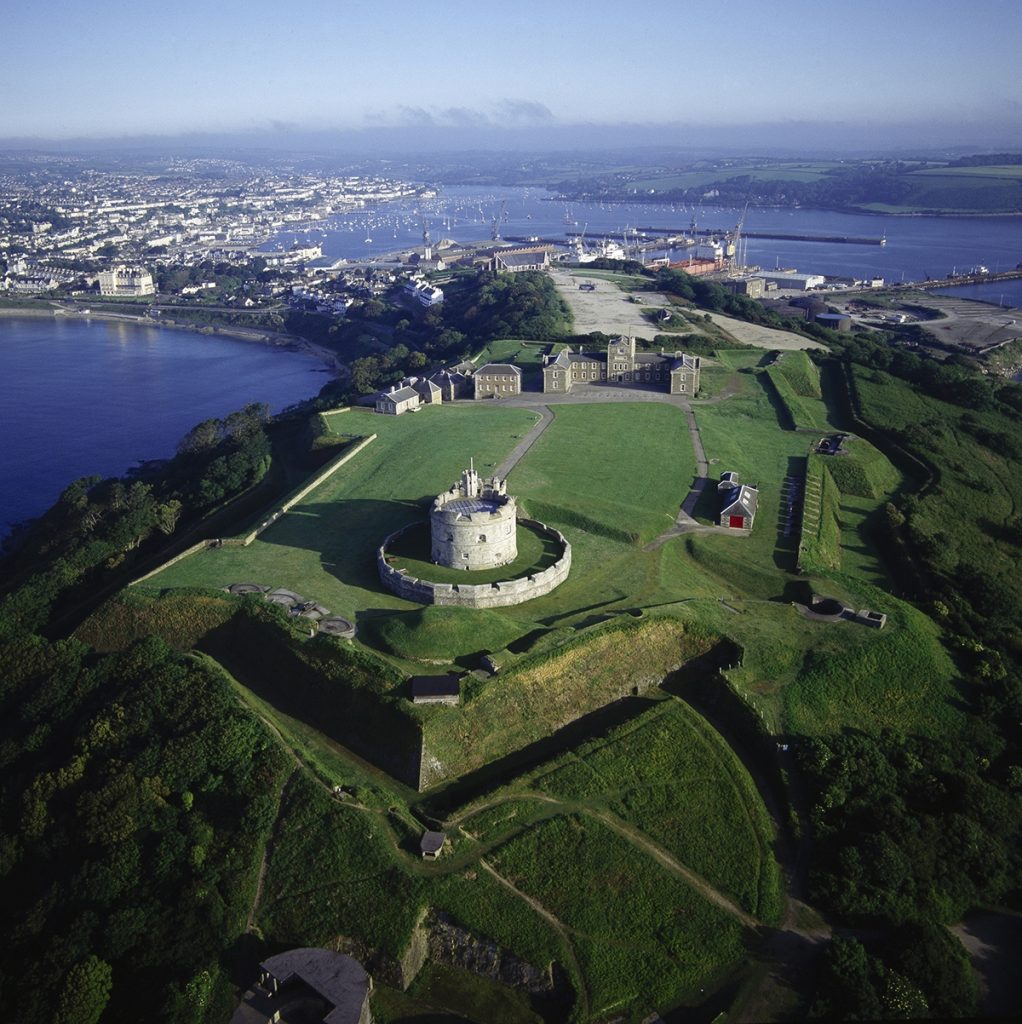
Pendennis Point, near Falmouth in Cornwall, is an exceptional destination for nature enthusiasts and marine life watchers – and yes, it’s possible to see various species of dolphin here too!
Dolphins don’t come here quite as often as places like Land’s End, as it’s relatively close to the larger town of Falmouth, but Pendennis Point is a fantastic vantage where you can enjoy almost 360-degree views of the Fal Estuary and Falmouth Bay. (Check out Pendennis Castle while you’re here too).
A pathway meanders around the headland – here you can enjoy sweeping views of the surrounding waters and whatever marine life it has to offer.
As well as common and bottlenose dolphins, you might also see seals and even basking sharks from May to September.
St Ives Bay

One of the most “tropical” feeling places in Cornwall, St Ives Bay is known for its palm trees and white sand beaches.
And, you guessed it – these coastal waters are prime for dolphins too!
Both Common and Bottlenose Dolphins are frequently spotted on various beaches in St Ives – I recommend starting the walk from St Ives to Zennor and watching out for them on the path.
The Rumps and Pentire Point
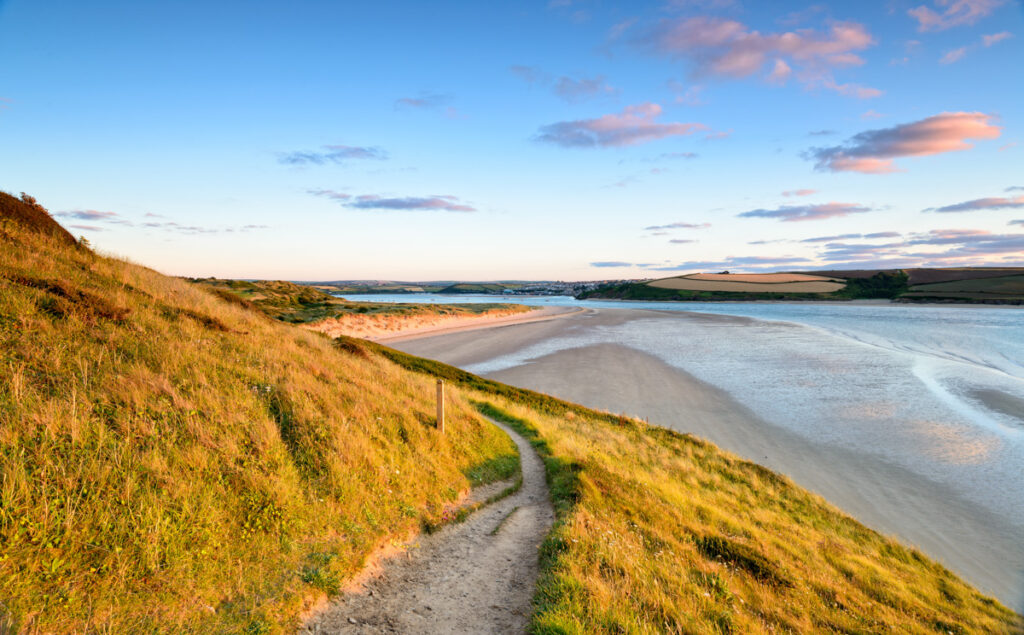
Up in northeastern Cornwall, close to Padstow and Port Issac, you’ll find The Rumps and Pentire Point, which are excellent places for looking out for Cornwall’s dolphins.
This National Trust-owned headland, located at the northeastern tip of the Camel Estuary mouth has a range of vantage points where you can admire local sea life.
The headland itself boasts sweeping views that extend from the Camel Estuary in the west, past Newlands and The Mouls islands, and eastward into Port Quin and Lundy Bay.
On clear days, visitors can even spot distant landmarks like Trevose Lighthouse, Tintagel Castle, and as far north as Duckpool, not far from the border of Devon.
The diversity of sea life is astounding. Regular sightings include dolphins, seals, porpoises, and the occasional Basking Shark and Oceanic Sunfish.
You can see dolphins throughout the year here, but they’re a little unpredictable – often, a pod of dolphins will move with fish shoals coming closer to the shore.
Bottlenose and Common Dolphins are the most frequently seen species, but occasionally, rarer ones like Risso’s Dolphin also make an appearance.
Both The Rumps and Pentire Point are conveniently located within half a mile of each other and are connected by the South West Coast Path.
This proximity makes them easily accessible, perfect for hiking and ideal for visitors who wish to experience the full range of natural beauty and wildlife that this area has to offer.
Looe
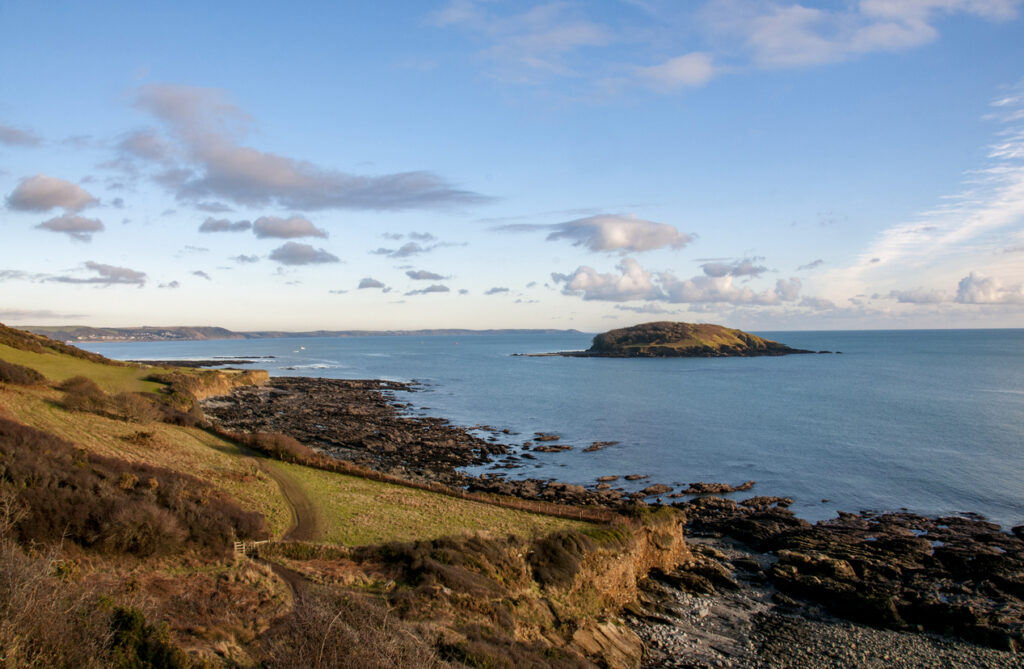
North Cornwall is usually renowned as the best place to see dolphins, but there are plenty frolicking on the coastline around Looe too!
If you want to see these fascinating creatures from South Cornwall, I’d recommend taking a Looe Sea Safari trip. It’s run by locals who’ve spent their whole life exploring the South Cornish waters, and with a RIB boat, you’ll get right in all the action!
Looe Island is also a popular vantage point to spot dolphins and other marine animals; you can take a boat from the mainland to the island to see if you can spot them!
We saw dolphins near Looe when we were on a boat trip around the area:
Isles of Scilly
If you’re heading to the Isles of Scilly from Penzance (in the summer months), keep your eyes peeled! There’s a high chance of seeing dolphins on the boat journey, along with pilot whales, orcas and even humpback whales on the Scillonian Ferry.
Being islands where life revolves around the water, it’s unsurprising that the Isles of Scilly are among the best places to see dolphins in Cornwall too.
Deep Point is an excellent spot for dolphin watching, or join a boat tour from St Mary’s.
Sennen Cove
Known for its surfing, Sennen Cove is also a popular dolphin-spotting destination!
This cove sits in striking distance from Land’s End, so you’ll often spot the same kind of wildlife here.
You might spot them on the short Sennen Cove to Land’s End walk.
However, I’d recommend walking north on the coast path (toward Pendeen) to look out for these graceful creatures. This part of the coastline is quieter and in my opinion, the hike is much more epic!
Rame Head

In an area known as “Forgotten Cornwall“, Rame Head is a prominent headland where pods of dolphins, minke whales and basking sharks have all been spotted.
This area is less visited than other parts of Cornwall because it’s harder to access (you have to cross over the Tamar from Plymouth and then basically drive back on yourself to get there – or you can take a boat in the summer months!) is actually in prime position to admire Cornwall’s diverse marine life.
From Rame Head, you can walk to Cawsand and Kingsand, two twin villages; as you walk along the coast path, don’t forget to keep looking in the sea to see if you can spot anything!
Is it worth doing a dolphin spotting boat trip in Cornwall?
Many of these places I’ve recommended, including Looe, Padstow, St Ives and Newquay, offer wildlife spotting boat tours.
It’s definitely worth doing one of these; you’ll be with a local expert who knows the best spots and animal behaviour which gives you a good chance of seeing some wildlife!
Plus, you’ll learn about the animals and their behaviour a little bit more.
Do be aware, however, that it’s never guaranteed that you’ll see any animals – nature can be unpredictable – so I’d recommend taking a boat trip for the views and experience, and treating any marine wildlife you see as a bonus.
Best time to see dolphins in Cornwall
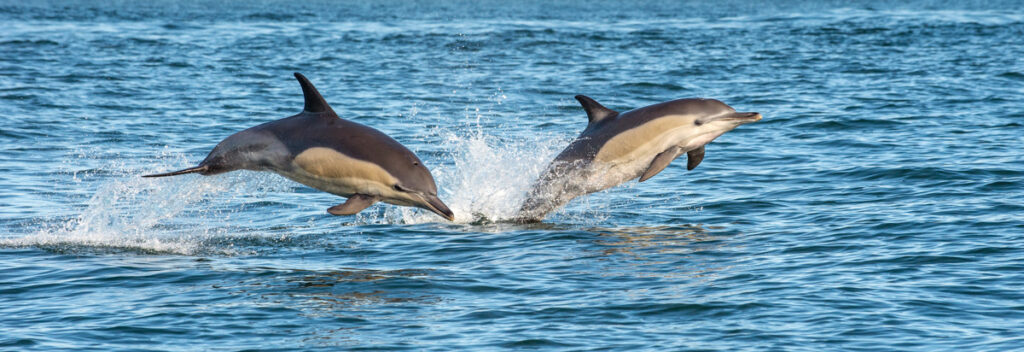
The warmer season, from April to October, is the best time to see dolphins on the Cornish coast – and the peak months are June, July and August. This, of course, coincides with the tourist season in Cornwall!
Dolphins prefer warmer sea temperatures, and the UK waters can be too chilly for them to be playing and active in the cooler season.
That said, it’s not impossible to see them throughout the year. I’ve personally seen them off the coast of Falmouth in March!
The peak season to see dolphins is also when most boat trips depart, thanks to the warmer, settled weather and increased tourist numbers – and this is the best way to see them.
How to see dolphins ethically
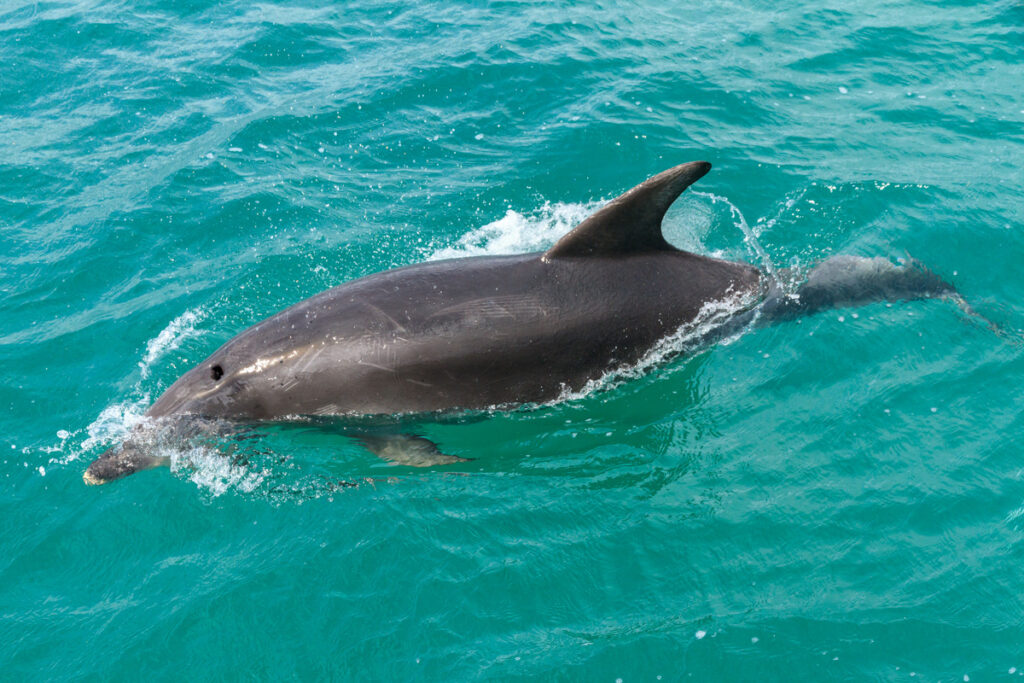
Of course, when having any kind of wildlife experience, it’s vital to do so ethically. Here’s how to respect dolphins:
- Maintain Distance: Always keep a respectful distance from dolphins, both when in a boat and when swimming. Avoid getting too close as it can stress the animals.
- No Feeding: Never feed dolphins. Feeding wild dolphins can alter their natural behaviour and make them dependent on human interaction.
- Quiet Observation: Observe dolphins quietly without making loud noises or sudden movements that could startle them.
- Follow Guidelines: Adhere to local guidelines and regulations regarding dolphin watching. These are put in place to protect the dolphins and their habitat.
- Do Not Touch: If you find yourself in the water with dolphins, never attempt to touch or interact with them physically. This can be invasive and stressful for the dolphins.
- Educate Yourself: Learn about dolphin behaviour and communication. Understanding their signals can help you identify if they are stressed or disturbed by your presence.
- Dispose of Rubbish Properly: Ensure that no litter or pollutants enter the ocean from your boat or person. Rubbish can be harmful to dolphins and their environment.
- Support Conservation Efforts: Engage with and support organizations that work towards the conservation of marine life, including dolphins. The Cornwall Wildlife Trust in Cornwall is excellent.
- Observe from Land When Possible: Observing dolphins from cliff tops is a great way to enjoy dolphin watching with minimal disturbance to them, although in small boats with experienced skippers is also fine.
Types of dolphins in Cornwall
- Common Dolphins are often seen around Cornwall’s coastline during warmer months, migrating to warmer seas in winter and usually spotted in pods.
- Bottlenose Dolphins are visible year-round along Cornwall’s coast, with a resident pod of 36 in Southwest England, typically seen in groups but sometimes alone.
- Risso’s Dolphins, known for inhabiting deeper waters for squid hunting, are a rarer sight near Cornwall but occasionally venture close to the coast.
What other marine animals can you see in Cornwall?
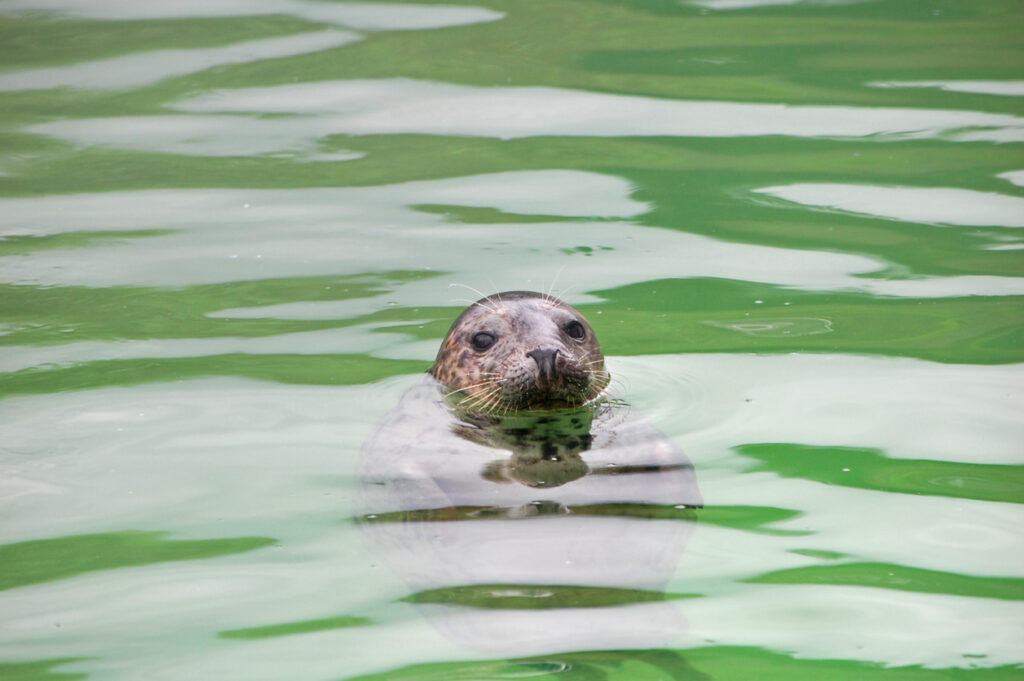
Going snorkelling in Cornwall or just planning on spending some time at the Duchy’s best beaches? Here’s what you might see:
- Grey Seals: Often seen lounging on rocky shores or swimming near the coastline. Check out my guide on where to see seals in Cornwall!
- Basking Sharks: The second-largest living shark species, commonly sighted in summer months.
- Harbour Porpoises: Smaller cetaceans that are frequently spotted, particularly in quieter bays.
- Oceanic Sunfish: An unusual and large fish species known for basking at the water’s surface.
- Jellyfish: Various species including the Moon jellyfish and the Lion’s Mane jellyfish.
- Sea Birds: Including puffins, gannets, fulmars, and the Cornish chough.
- Migratory Fish: Such as mackerel and tuna, especially during the warmer months.
- Sea Turtles: Rare but occasional visitors like the leatherback turtle.
- Whimbrels and Purple Sandpipers: Bird species often seen during their seasonal passages.
- Common Octopus and Cuttlefish: Known for their camouflage abilities and often found in rocky seabed areas.
- Starfish and Sea Urchins: Found in rock pools and along the shallow seabed.
- Crustaceans: Including crabs and lobsters, often spotted in rock pools or near the seabed.
- Various Shellfish: Such as mussels, clams, and oysters, thriving in the intertidal zones.
- Manx Shearwaters and Storm Petrels: Seabirds that visit Cornwall’s coastal waters.
- Cetaceans: Occasional sightings of other whale species, including orcas, minke and humpback whales – although they’re less common.
So, can you see dolphins in Cornwall?
Absolutely, there are dolphins around Cornwall, and if you visit these spots in this article you may well see them! Just remember, you’re dealing with unpredictable nature, so spotting them is never guaranteed.
Check out my Cornwall archives for more tips on planning your trip here, or drop me a message on Instagram if you have any questions!

